2008 MERCEDES-BENZ CLS COUPE window
[x] Cancel search: windowPage 26 of 329
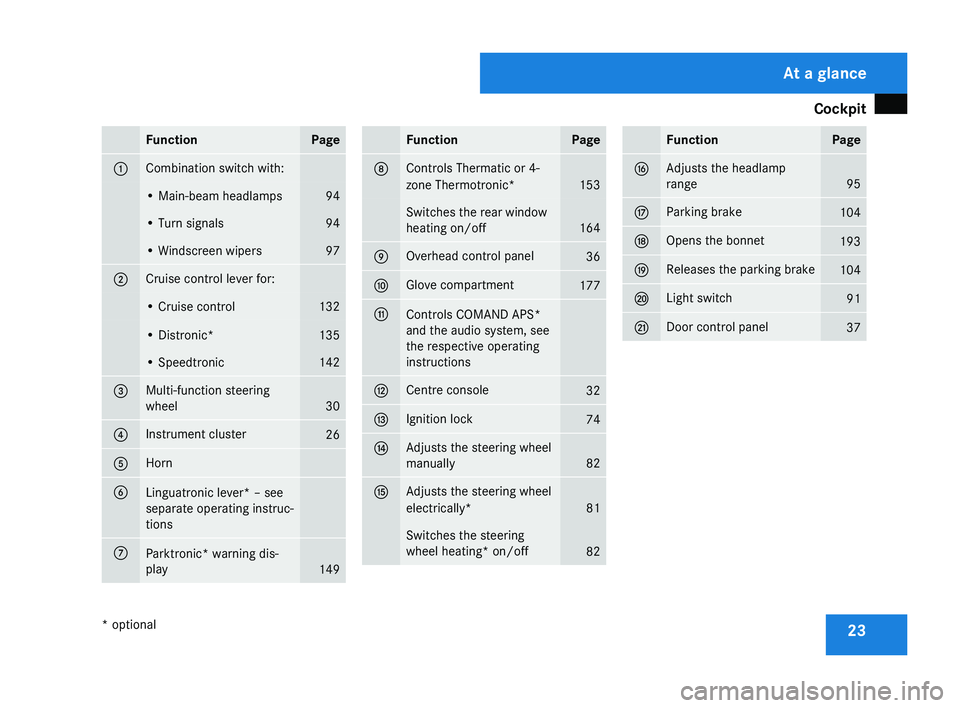
Cockpit
23Function Page
1 Combination switch with:
• Main-beam headlamps 94
• Turn signals 94
• Windscreen wipers 97
2 Cruise control lever for:
• Cruise control 132
• Distronic* 135
• Speedtronic 142
3 Multi-function steering
wheel
30
4 Instrument cluster
26
5 Horn
6
Linguatronic lever* – see
separate operating instruc-
tions
7
Parktronic* warning dis-
play
149 Function Page
8 Controls Thermatic or 4-
zone Thermotronic*
153
Switches the rear window
heating on/off
164
9 Overhead control panel
36
a Glove compartment
177
b
Controls COMAND APS*
and the audio system, see
the respective operating
instructions
c Centre console
32
d Ignition lock
74
e Adjusts the steering wheel
manually
82
f Adjusts the steering wheel
electrically*
81
Switches the steering
wheel heating* on/off
82 Function Page
g Adjusts the headlamp
range
95
h Parking brake
104
j Opens the bonnet
193
k Releases the parking brake
104
l Light switch
91
m Door control panel
37At a glance
* optional
219_AKB; 2; 4, en-GB
mkalafa,
2007-11-13T09:28:36+01:00 - Seite 23
Page 28 of 329
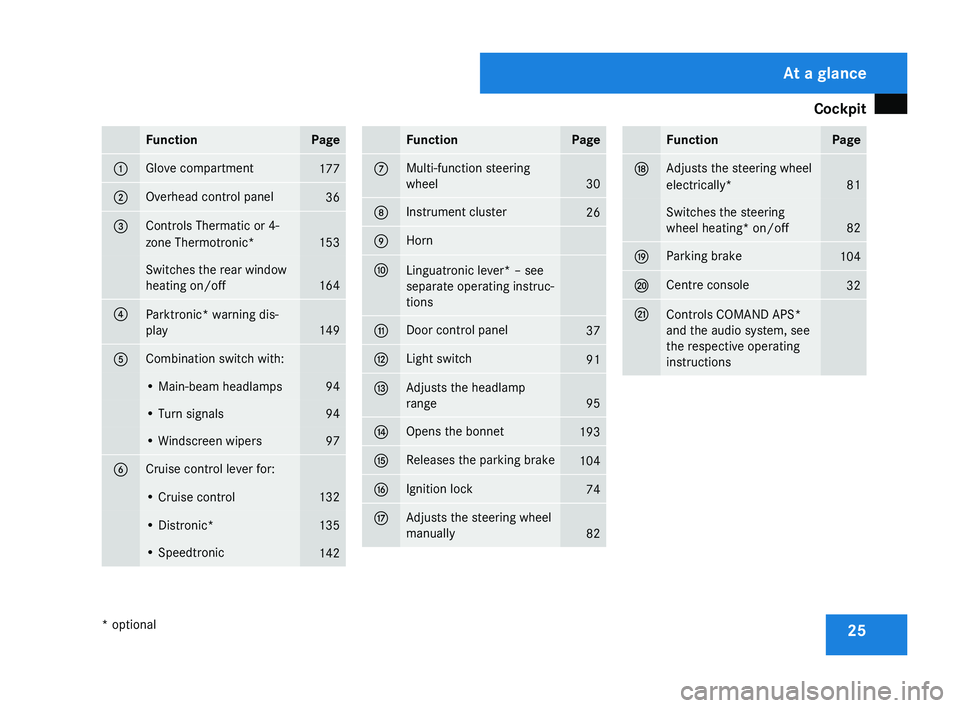
Cockpit
25Function Page
1 Glove compartment
177
2 Overhead control panel
36
3 Controls Thermatic or 4-
zone Thermotronic*
153
Switches the rear window
heating on/off
164
4
Parktronic* warning dis-
play
149
5 Combination switch with:
• Main-beam headlamps 94
• Turn signals 94
• Windscreen wipers 97
6 Cruise control lever for:
• Cruise control 132
• Distronic* 135
• Speedtronic
142 Function Page
7 Multi-function steering
wheel
30
8 Instrument cluster
26
9 Horn
a
Linguatronic lever* – see
separate operating instruc-
tions
b Door control panel
37
c Light switch
91
d Adjusts the headlamp
range
95
e Opens the bonnet
193
f Releases the parking brake
104
g Ignition lock
74
h Adjusts the steering wheel
manually
82 Function Page
j Adjusts the steering wheel
electrically*
81
Switches the steering
wheel heating* on/off
82
k Parking brake
104
l Centre console
32
m
Controls COMAND APS*
and the audio system, see
the respective operating
instructions At a glance
* optional
219_AKB; 2; 4, en-GB
mkalafa,
2007-11-13T09:28:36+01:00 - Seite 25
Page 38 of 329

Centre console
35Function Page
1
Switches the seat heating*
on the left-hand side on/off
80
2 Rolls the rear window
blind* up/down
180
3 Folds back the rear seat
head restraints
79
4 Switches the hazard warn-
ing lamps on/off
94
5 5 PASSENGER AIRBAG
OFF warning lamp
5 51
6 Unlocks the vehicle
70
7
ATA indicator lamp* 61
8 Deactivates/activates
ESP
® 59
9
Switches the seat heating*
on the right-hand side on/
off
80 Function Page
a Switches the seat ventila-
tion* on the right-hand side
on/off
80
b Locks the vehicle
70
c Opening button CD
changer*– see the
the separate operating
instructions
d Switches the seat ventila-
tion* on the left-hand side
on/off
80
5
The warning lamp lights up briefly when the key is turned to position 2 in the ignition lock, even on vehicles which do not have automatic child seat recognition* on
the front-passenger seat. In that case it has no function and does not indicate that the front-passenger seat is equipped with automatic child seat recognition*. At a glance
* optional
219_AKB; 2; 4, en-GB
mkalafa,
2007-11-13T09:28:36+01:00 - Seite 35
Page 48 of 329
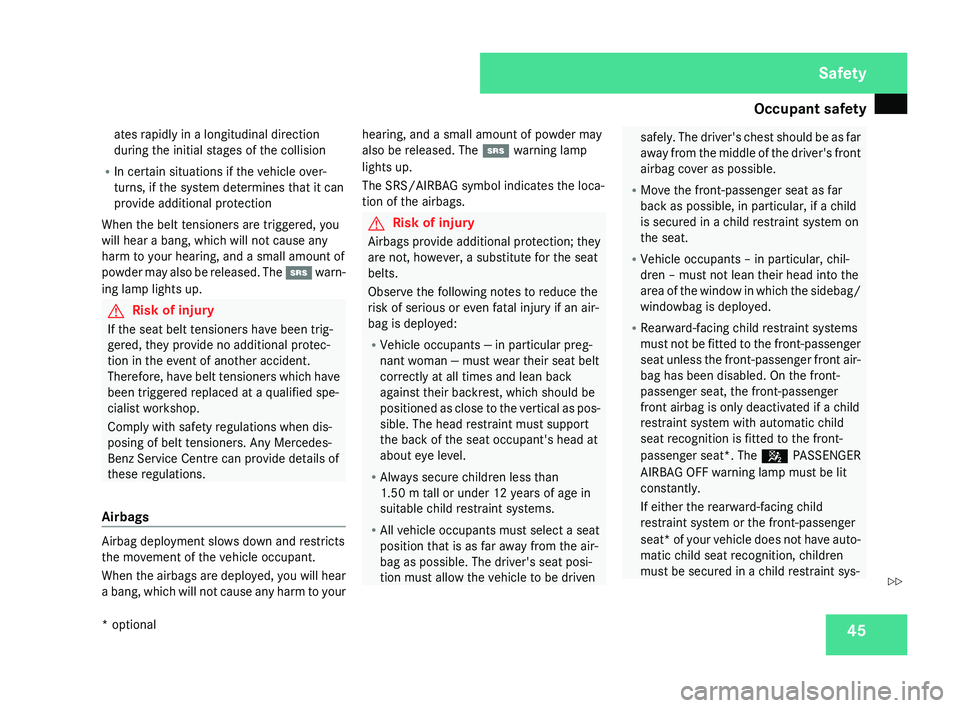
Occupant safety
45
ates rapidly in a longitudinal direction
during the initial stages of the collision
R In certain situations if the vehicle over-
turns, if the system determines that it can
provide additional protection
When the belt tensioners are triggered, you
will hear a bang, which will not cause any
harm to your hearing, and a small amount of
powder
may also be released. The 1 warn-
ing lamp lights up. G
Risk of injury
If the seat belt tensioners have been trig-
gered, they provide no additional protec-
tion in the event of another accident.
Therefore,
have belt tensioners which have
been triggered replaced at a qualified spe-
cialist workshop.
Comply with safety regulations when dis-
posing of belt tensioners. Any Mercedes-
Benz Service Centre can provide details of
these regulations.
Airbags Airbag deployment slows down and restricts
the movement of the vehicle occupant.
When
the airbags are deployed, you will hear
a bang, which will not cause any harm to your hearing, and a small amount of powder may
also be released. The
1 warning lamp
lights up.
The SRS/AIRBAG symbol indicates the loca-
tion of the airbags. G
Risk of injury
Airbags provide additional protection; they
are not, however, a substitute for the seat
belts.
Observe the following notes to reduce the
risk of serious or even fatal injury if an air-
bag is deployed:
R Vehicle occupants — in particular preg-
nant woman — must wear their seat belt
correctly at all times and lean back
against their backrest, which should be
positioned
as close to the vertical as pos-
sible. The head restraint must support
the back of the seat occupant's head at
about eye level.
R Always secure children less than
1.50 m tall or under 12 years of age in
suitable child restraint systems.
R All vehicle occupants must select a seat
position that is as far away from the air-
bag as possible. The driver's seat posi-
tion must allow the vehicle to be driven safely. The driver's chest should be as far
away
from the middle of the driver's front
airbag cover as possible.
R Move the front-passenger seat as far
back as possible, in particular, if a child
is secured in a child restraint system on
the seat.
R Vehicle occupants – in particular, chil-
dren – must not lean their head into the
area of the window in which the sidebag/
windowbag is deployed.
R Rearward-facing child restraint systems
must not be fitted to the front-passenger
seat unless the front-passenger front air-
bag has been disabled. On the front-
passenger seat, the front-passenger
front airbag is only deactivated if a child
restraint system with automatic child
seat recognition is fitted to the front-
passenger seat*. The 5 PASSENGER
AIRBAG OFF warning lamp must be lit
constantly.
If either the rearward-facing child
restraint system or the front-passenger
seat* of your vehicle does not have auto-
matic child seat recognition, children
must be secured in a child restraint sys- Safety
* optional
219_AKB; 2; 4, en-GB
mkalafa,
2007-11-13T09:28:36+01:00 - Seite 45 Z
Page 49 of 329
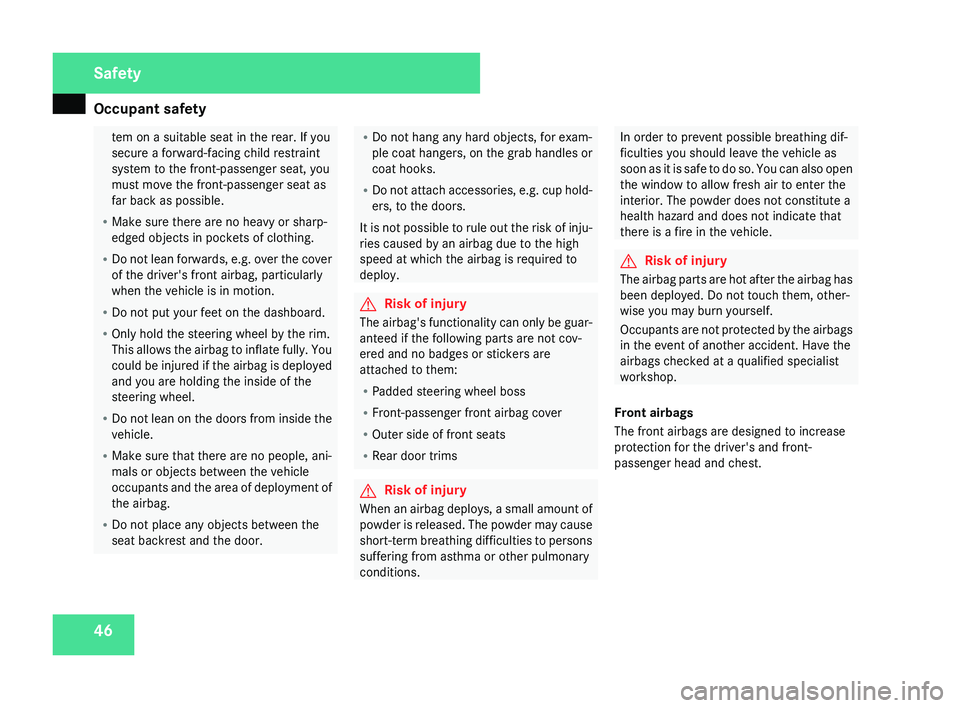
Occupant safety
46 tem on a suitable seat in the rear. If you
secure a forward-facing child restraint
system to the front-passenger seat, you
must move the front-passenger seat as
far back as possible.
R Make sure there are no heavy or sharp-
edged objects in pockets of clothing.
R Do
not lean forwards, e.g. over the cover
of the driver's front airbag, particularly
when the vehicle is in motion.
R Do not put your feet on the dashboard.
R Only hold the steering wheel by the rim.
This allows the airbag to inflate fully. You
could be injured if the airbag is deployed
and you are holding the inside of the
steering wheel.
R Do not lean on the doors from inside the
vehicle.
R Make sure that there are no people, ani-
mals or objects between the vehicle
occupants and the area of deployment of
the airbag.
R Do not place any objects between the
seat backrest and the door. R
Do not hang any hard objects, for exam-
ple
coat hangers, on the grab handles or
coat hooks.
R Do not attach accessories, e.g. cup hold-
ers, to the doors.
It is not possible to rule out the risk of inju-
ries caused by an airbag due to the high
speed at which the airbag is required to
deploy. G
Risk of injury
The airbag's functionality can only be guar-
anteed if the following parts are not cov-
ered and no badges or stickers are
attached to them:
R Padded steering wheel boss
R Front-passenger front airbag cover
R Outer side of front seats
R Rear door trims G
Risk of injury
When an airbag deploys, a small amount of
powder
is released. The powder may cause
short-term breathing difficulties to persons
suffering from asthma or other pulmonary
conditions. In order to prevent possible breathing dif-
ficulties you should leave the vehicle as
soon
as it is safe to do so. You can also open
the window to allow fresh air to enter the
interior. The powder does not constitute a
health hazard and does not indicate that
there is a fire in the vehicle. G
Risk of injury
The airbag parts are hot after the airbag has
been deployed. Do not touch them, other-
wise you may burn yourself.
Occupants
are not protected by the airbags
in the event of another accident. Have the
airbags checked at a qualified specialist
workshop.
Front airbags
The front airbags are designed to increase
protection for the driver's and front-
passenger head and chest. Safety
219_AKB; 2; 4, en-GB
mkalafa,
2007-11-13T09:28:36+01:00 - Seite 46
Page 51 of 329
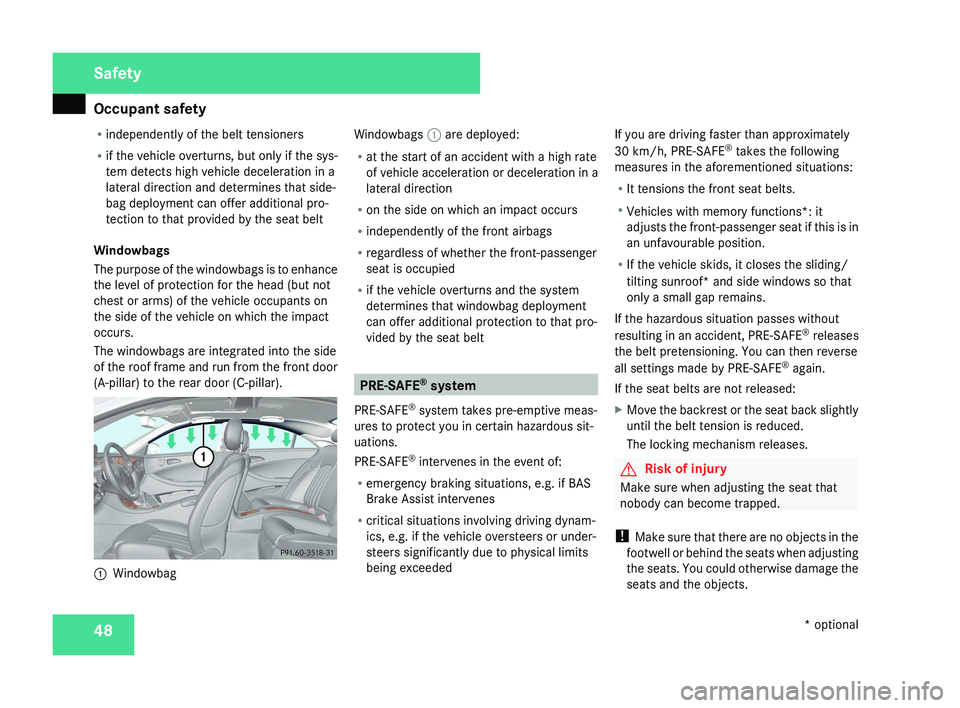
Occupant safety
48
R
independently of the belt tensioners
R if the vehicle overturns, but only if the sys-
tem detects high vehicle deceleration in a
lateral direction and determines that side-
bag deployment can offer additional pro-
tection to that provided by the seat belt
Windowbags
The purpose of the windowbags is to enhance
the level of protection for the head (but not
chest or arms) of the vehicle occupants on
the side of the vehicle on which the impact
occurs.
The windowbags are integrated into the side
of the roof frame and run from the front door
(A-pillar) to the rear door (C-pillar).1 Windowbag Windowbags
1 are deployed:
R at the start of an accident with a high rate
of vehicle acceleration or deceleration in a
lateral direction
R on the side on which an impact occurs
R independently of the front airbags
R regardless of whether the front-passenger
seat is occupied
R if the vehicle overturns and the system
determines that windowbag deployment
can offer additional protection to that pro-
vided by the seat belt
PRE-SAFE ®
system
PRE-SAFE ®
system takes pre-emptive meas-
ures to protect you in certain hazardous sit-
uations.
PRE-SAFE ®
intervenes in the event of:
R emergency braking situations, e.g. if BAS
Brake Assist intervenes
R critical situations involving driving dynam-
ics, e.g. if the vehicle oversteers or under-
steers significantly due to physical limits
being exceeded If you are driving faster than approximately
30 km/h, PRE-SAFE
®
takes the following
measures in the aforementioned situations:
R It tensions the front seat belts.
R Vehicles with memory functions*: it
adjusts the front-passenger seat if this is in
an unfavourable position.
R If the vehicle skids, it closes the sliding/
tilting sunroof* and side windows so that
only a small gap remains.
If the hazardous situation passes without
resulting in an accident, PRE-SAFE ®
releases
the belt pretensioning. You can then reverse
all settings made by PRE-SAFE ®
again.
If the seat belts are not released:
X Move the backrest or the seat back slightly
until the belt tension is reduced.
The locking mechanism releases.
G Risk of injury
Make sure when adjusting the seat that
nobody can become trapped.
! Make sure that there are no objects in the
footwell or behind the seats when adjusting
the seats. You could otherwise damage the
seats and the objects.
Safety
* optional
219_AKB; 2; 4, en-GB
mkalafa,
2007-11-13T09:28:36+01:00 - Seite 48
Page 55 of 329
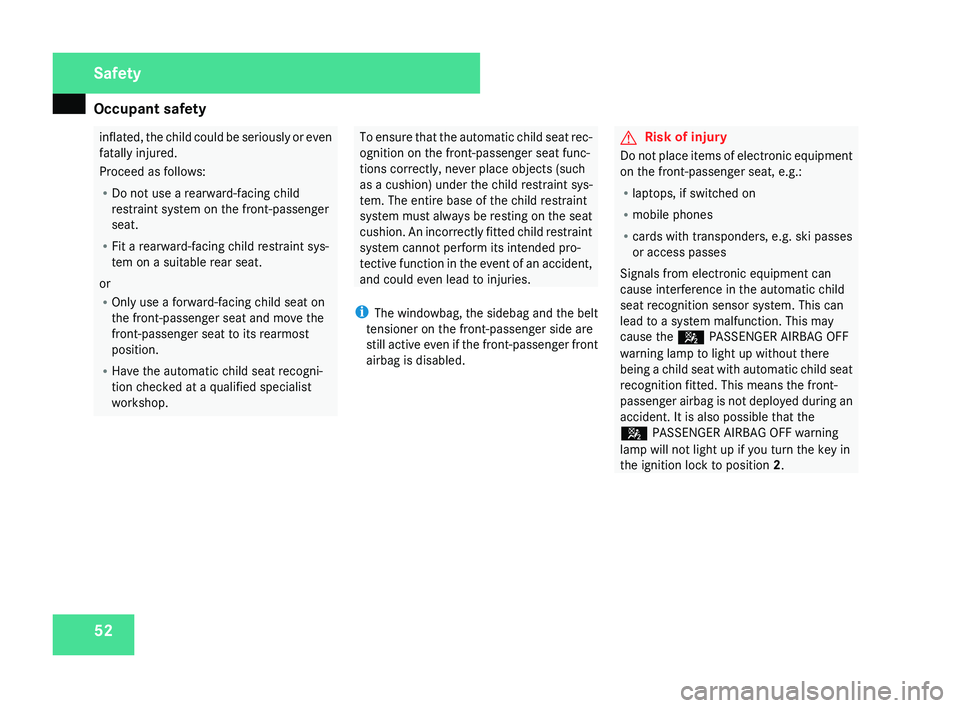
Occupant safety
52 inflated, the child could be seriously or even
fatally injured.
Proceed as follows:
R
Do not use a rearward-facing child
restraint system on the front-passenger
seat.
R Fit a rearward-facing child restraint sys-
tem on a suitable rear seat.
or
R Only use a forward-facing child seat on
the front-passenger seat and move the
front-passenger seat to its rearmost
position.
R Have the automatic child seat recogni-
tion checked at a qualified specialist
workshop. To ensure that the automatic child seat rec-
ognition on the front-passenger seat func-
tions correctly, never place objects (such
as a cushion) under the child restraint sys-
tem. The entire base of the child restraint
system
must always be resting on the seat
cushion. An incorrectly fitted child restraint
system cannot perform its intended pro-
tective function in the event of an accident,
and could even lead to injuries.
i The windowbag, the sidebag and the belt
tensioner on the front-passenger side are
still active even if the front-passenger front
airbag is disabled. G
Risk of injury
Do not place items of electronic equipment
on the front-passenger seat, e.g.:
R laptops, if switched on
R mobile phones
R cards with transponders, e.g. ski passes
or access passes
Signals from electronic equipment can
cause interference in the automatic child
seat recognition sensor system. This can
lead to a system malfunction. This may
cause the 5 PASSENGER AIRBAG OFF
warning lamp to light up without there
being
a child seat with automatic child seat
recognition fitted. This means the front-
passenger airbag is not deployed during an
accident. It is also possible that the
5 PASSENGER AIRBAG OFF warning
lamp will not light up if you turn the key in
the ignition lock to position 2.Safety
219_AKB; 2; 4, en-GB
mkalafa,
2007-11-13T09:28:36+01:00 - Seite 52
Page 59 of 329
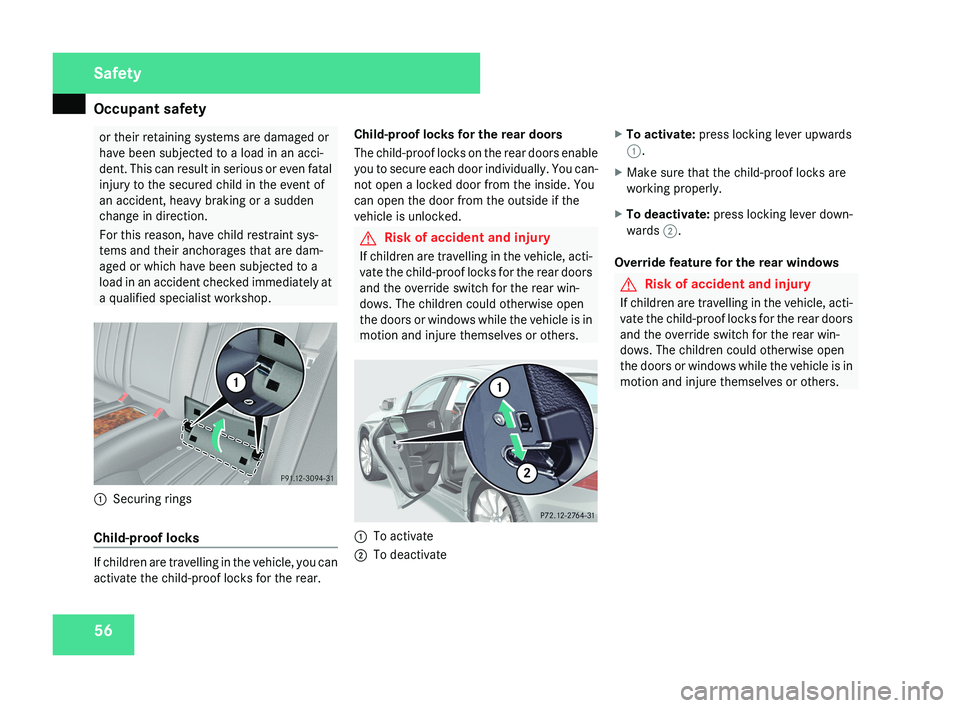
Occupant safety
56 or their retaining systems are damaged or
have been subjected to a load in an acci-
dent. This can result in serious or even fatal
injury to the secured child in the event of
an accident, heavy braking or a sudden
change in direction.
For this reason, have child restraint sys-
tems and their anchorages that are dam-
aged or which have been subjected to a
load in an accident checked immediately at
a qualified specialist workshop.1
Securing rings
Child-proof locks
If children are travelling in the vehicle, you can
activate the child-proof locks for the rear. Child-proof locks for the rear doors
The child-proof locks on the rear doors enable
you to secure each door individually. You can-
not open a locked door from the inside. You
can open the door from the outside if the
vehicle is unlocked.
G
Risk of accident and injury
If children are travelling in the vehicle, acti-
vate the child-proof locks for the rear doors
and the override switch for the rear win-
dows. The children could otherwise open
the doors or windows while the vehicle is in
motion and injure themselves or others.
1 To activate
2 To deactivate X
To activate: press locking lever upwards
1.
X Make sure that the child-proof locks are
working properly.
X To deactivate: press locking lever down-
wards 2.
Override feature for the rear windows
G Risk of accident and injury
If children are travelling in the vehicle, acti-
vate the child-proof locks for the rear doors
and the override switch for the rear win-
dows. The children could otherwise open
the doors or windows while the vehicle is in
motion and injure themselves or others.
Safety
219_AKB; 2; 4, en-GB
mkalafa,
2007-11-13T09:28:36+01:00 - Seite 56